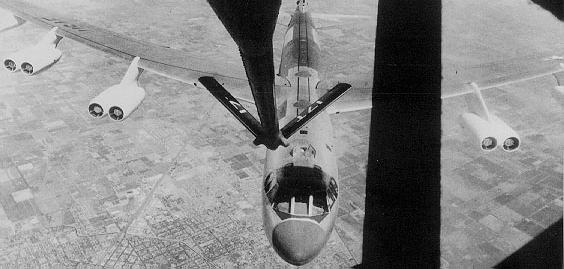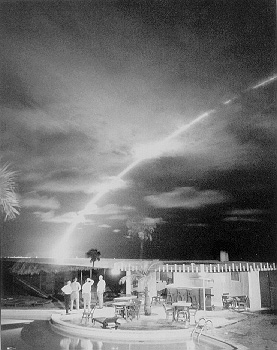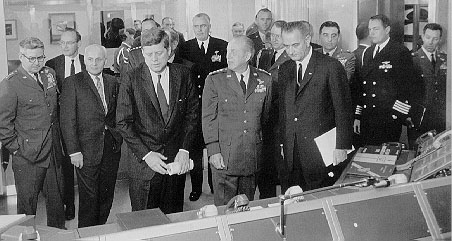
 U.S. Nuclear History: Nuclear Arms and Politics in the Missile Age, 1955-1968 documents one of the
most formidable military buildups of the nuclear era. It begins with 1955, when the U.S. Air Force acquired its first B-52 bomber,
massively destructive thermonuclear weapons entered the weapons stockpile in large numbers, and President Eisenhower declared
the production of operational intercontinental ballistic missiles (ICBMs)
the highest national priority. During the following years,
the United States produced and deployed a potentially devastating array of Atlas, Titan, and Minuteman ICBMs and Polaris submarine-launched
ballistic missiles (SLBMs), all poised for rapid retaliation or first-strike in a crisis. In addition to its own rapid nuclear expansion, the United States
also deployed thousands of nuclear missiles in Western Europe during the 1960s to uphold alliance commitments with European
powers. This collection concludes with 1968, when a new phase in nuclear history was approaching; with the Soviets reaching
strategic parity, the White House began making arms control negotiations a priority, and the Air Force successfully tested multiple independently
targetable reentry vehicles (MIRVs) to enhance the destructive reach of ballistic missiles.
U.S. Nuclear History: Nuclear Arms and Politics in the Missile Age, 1955-1968 documents one of the
most formidable military buildups of the nuclear era. It begins with 1955, when the U.S. Air Force acquired its first B-52 bomber,
massively destructive thermonuclear weapons entered the weapons stockpile in large numbers, and President Eisenhower declared
the production of operational intercontinental ballistic missiles (ICBMs)
the highest national priority. During the following years,
the United States produced and deployed a potentially devastating array of Atlas, Titan, and Minuteman ICBMs and Polaris submarine-launched
ballistic missiles (SLBMs), all poised for rapid retaliation or first-strike in a crisis. In addition to its own rapid nuclear expansion, the United States
also deployed thousands of nuclear missiles in Western Europe during the 1960s to uphold alliance commitments with European
powers. This collection concludes with 1968, when a new phase in nuclear history was approaching; with the Soviets reaching
strategic parity, the White House began making arms control negotiations a priority, and the Air Force successfully tested multiple independently
targetable reentry vehicles (MIRVs) to enhance the destructive reach of ballistic missiles.
Sample Document: State Department memorandum on "Use of Atomic Weapons" from Gerard C. Smith and Robert R. Bowie to Secretary of State Dulles recommending accepting plans for predelegating authority to commander-in-chief, Strategic Air Command to use nuclear weapons in the event that a nuclear attack prevents communication with the president, 15 May 1957.
Sample Document: "Air Force Presentation to the Joint Chiefs of Staff on the Air Force Review of Atomic Annexes," asserting that plans for massive destruction of Soviet atomic targets will cause "perhaps unnecessary" destruction in the Sino-Soviet bloc and "some sickness, or even deaths, in friendly areas," 24 August 1957.

President John F. Kennedy at the Command Post during a tour of Strategic Air Command Headquarters, Offut Air Force Base, Nebraska, December 1962. Pictured in the front from the left are Air Force Chief of Staff General Curtis LeMay, Secretary of the Air Force Eugene Zuckert, President Kennedy, SAC Commander-in-Chief General Thomas Power, Vice President Lyndon B. Johnson, White House Air Aide Colonel Godfrey McHugh, White House Naval Aide Captain Tazewell Shepard, and an unidentified person. Standing between Johnson and Power is Chief of Naval Operations George Anderson; behind Johnson to his right is White House Military Aide General Chester V. Clifton. Photograph courtesy of the John F. Kennedy Presidential Library.
U.S. Nuclear History, 1955-1968 provides a wealth of information and documentation on key issues in U.S. nuclear policy. Among the specific areas and issues documented are:
Among the collection's highlights are:
The Guide includes an essay; events chronology; glossaries of key individuals, organizations, abbreviations, terms, and weapons and warnings systems; document catalog; and bibliography of secondary sources.
11/07/1956 C. Burke Elbrick, Deputy Assistant Secretary of State for European and Canadian Affairs, to Acting Secretary of State, Program to Increase NATO Nuclear Capability and Secure Certain Base Rights, Secret Memorandum
c. 01/15/1957 Naval Warfare Analysis Group, NAVWAG Study 1, Introduction of the
Fleet Ballistic Missile Into Service, Secret Report
08/21/1959 General Nathan Twining, Chairman, Joint Chiefs of Staff, Target
Coordination and Associated Problems, Top Secret Memorandum for the
Secretary of Defense
c. 12/00/1959 Joint Chiefs of Staff, Instructions for Expenditure of Nuclear Weapons in Emergency Conditions, Top Secret Memorandum for Commander in Chief, Strategic Air Command
12/04/1960 Admiral Arleigh Burke, Special Edition Flag Officers Dope, National Strategic Target List and Single Integrated Operational Plan, Secret Memorandum
9/13/60 Harrison W. Burgess, Department of State Office of British Commonwealth and Northern European Affairs, U.S. Flights Over Canada Involving Nuclear Weapons, Top Secret Memorandum
11/06/1961 Department of Defense, Rationale of U.S. Policy in the Berlin Crisis from the NATO Standpoint, Top Secret Memorandum
04/00/1962 Robert F. Piper, U.S. Air Force Systems Command, Historical Office, The Development of the SM-80 Minuteman, Secret History
06/08/1962 John H. Pender, U.S. Department of State Legal Adviser for Special Functional Problems, Operation of NATO Stockpile Program: Survey of Security Arrangements for United States Atomic Weapons with NATO Units (April 1962), Secret Memorandum
03/05/1964 Major General John W. Carpenter, Director of Plans, Office of the Deputy Chief of Staff for Plans and Operations, The Air Force Concept of a U.S. Military Strategy, Top Secret Address to Air War College, Maxwell Air Force Base
11/08/1966 U.S. Department of State, Bureau of Politico-Military Affairs, Secretary McNamara's Five Year Force Structure Memorandum on Strategic Forces, Top Secret Report
4/22/1968 U.S. Ambassador to North Atlantic Treaty Organization Harlan Cleveland to Secretary of Defense Clark Clifford, The Nuclear Planning Group, Secret Cable
00/00/1975 L. Wainstein et al., Institute for Defense Analyses, The Evolution of U.S. Strategic Command and Control and Warning, 1945-1972, Top Secret History
02/00/1976 Daniel Ruchonnet, Lawrence Livermore National Laboratory, MIRV: A Brief History of Minuteman and Multiple Reentry Vehicles, Secret History
Content
Reproduces on microfiche 1,446 U.S. government records totaling 20,336 pages of
documentation concerning the development of America's nuclear weapons posture during
the period 1955-1968, one of the most perilous of the Cold War.
Materials were identified, obtained, assembled, and indexed by the National Security
Archive.
Series
The Special Collections
Arrangement
Microfiche are arranged chronologically. For ease of use, each document bears a unique
accession number to which all indexing is keyed.
Standards
The documents are reproduced on 35mm silver halide archivally permanent positive microfiche conforming to NMA and
BSI standards.
Any microfiche found to be physically substandard in any way will be replaced free of charge.
Indexing
A printed Guide and Index accompanies the microfiche collection. The Guide contains
an events chronology, glossaries, chronological document catalog and a bibliography of secondary sources.
The Index provides in-depth, document level access to subjects and individuals.
Date of Publication
January 1998
Orders and Inquiries
Contact Chadwyck-Healey, Inc. for orders and inquiries (click here).
Robert S. Norris, Senior Research Associate, Natural Resources Defense Council,
Washington, D.C.
David Rosenberg, Associate Professor, History Department, Temple University and Visiting Professor, Admiral Harry W. Hill Chair in Maritime Strategy, National War College
"The decade and a half from the mid-1950s through the late 1960s was the critical
period in the nuclear relationship between the United States and the Soviet Union. The
National Security Archive’s special collection of recently declassified government files
and studies, From the H-Bomb to the MIRV: U.S. Nuclear Weapons Strategy,
Operations, and Systems, 1955-1968, thoroughly documents American decision-making
on policies and preparation for nuclear conflict. It contains much new material that will
change our understanding of this crucial era, and will become the starting point for
scholars and students researching the nuclear arms competition during this time."
David A. Rosenberg
Professor of History, Temple University
Visiting Professor, Admiral Harry W. Hill Chair in Maritime Strategy, National
War College
"The most wide-ranging collection of nuclear weapon strategy and policy documents
ever assembled in one place, this is a "must" for the serious Cold War historian or
history library. From the H-Bomb to the MIRV is a valuable shortcut through the
interminable Freedom of Information process."
Chuck Hansen
Author, U.S. Nuclear Weapons: The Secret History
Editor, The Swords of Armageddon
"This collection permits researchers to have a major archive on nuclear weapons issues
right at their finger tips. These declassified documents are essential for understanding
the hidden history of the Cold War."
Scott D. Sagan
Co-director, Center for International Security and Arms Control, Stanford
University